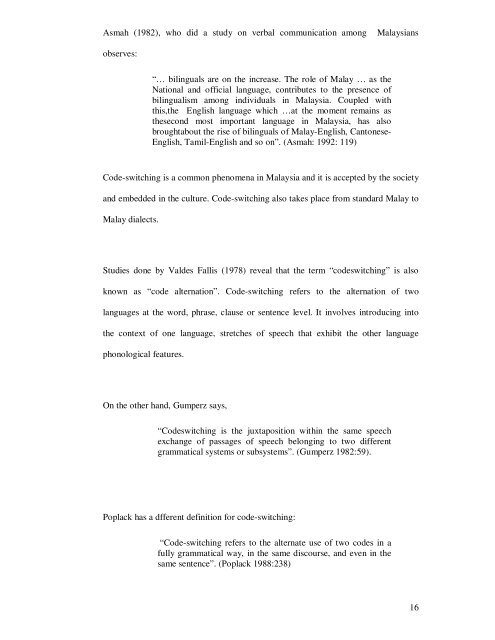CHAPTER 1 1.0 Introduction - DSpace@UM - University of Malaya
CHAPTER 1 1.0 Introduction - DSpace@UM - University of Malaya
CHAPTER 1 1.0 Introduction - DSpace@UM - University of Malaya
Create successful ePaper yourself
Turn your PDF publications into a flip-book with our unique Google optimized e-Paper software.
Asmah (1982), who did a study on verbal communication among Malaysians<br />
observes:<br />
“… bilinguals are on the increase. The role <strong>of</strong> Malay … as the<br />
National and <strong>of</strong>ficial language, contributes to the presence <strong>of</strong><br />
bilingualism among individuals in Malaysia. Coupled with<br />
this,the English language which …at the moment remains as<br />
thesecond most important language in Malaysia, has also<br />
broughtabout the rise <strong>of</strong> bilinguals <strong>of</strong> Malay-English, Cantonese-<br />
English, Tamil-English and so on”. (Asmah: 1992: 119)<br />
Code-switching is a common phenomena in Malaysia and it is accepted by the society<br />
and embedded in the culture. Code-switching also takes place from standard Malay to<br />
Malay dialects.<br />
Studies done by Valdes Fallis (1978) reveal that the term “codeswitching” is also<br />
known as “code alternation”. Code-switching refers to the alternation <strong>of</strong> two<br />
languages at the word, phrase, clause or sentence level. It involves introducing into<br />
the context <strong>of</strong> one language, stretches <strong>of</strong> speech that exhibit the other language<br />
phonological features.<br />
On the other hand, Gumperz says,<br />
“Codeswitching is the juxtaposition within the same speech<br />
exchange <strong>of</strong> passages <strong>of</strong> speech belonging to two different<br />
grammatical systems or subsystems”. (Gumperz 1982:59).<br />
Poplack has a dfferent definition for code-switching:<br />
“Code-switching refers to the alternate use <strong>of</strong> two codes in a<br />
fully grammatical way, in the same discourse, and even in the<br />
same sentence”. (Poplack 1988:238)<br />
16

















